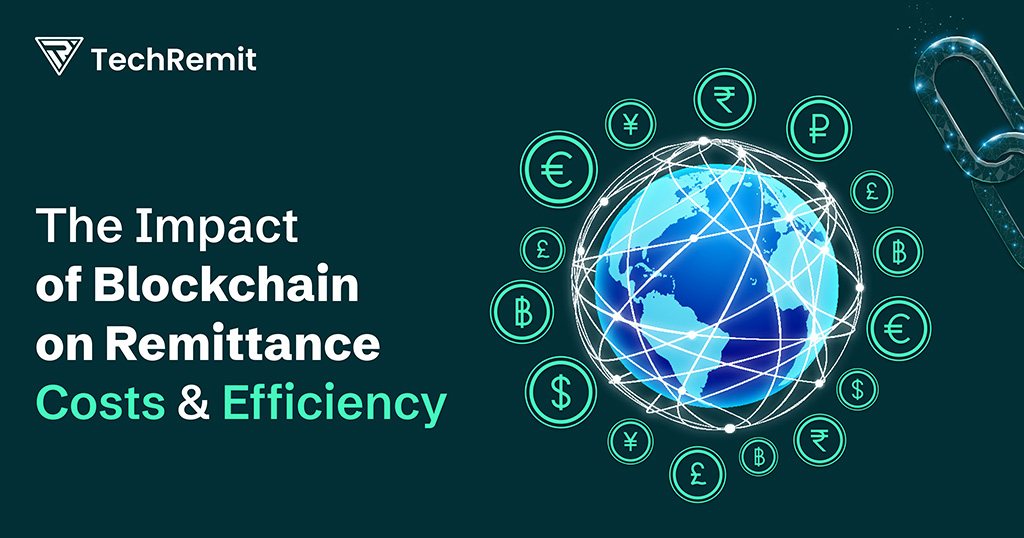The Impact of Blockchain on Remittance Costs and Efficiency

Remittances play a critical role in supporting families, strengthening local economies, contributing to countries’ development, and helping to balance foreign exchange reserves. In order to enhance these remittance services, there has been a notable transition from traditional transfer systems to sophisticated remittance solutions in this industry. Even though these changes have greatly enhanced cross-border transactions, there are still certain problems, such as high remittance costs and lower efficiency. Thus, to improve even more, industry experts are supporting the use of modern technologies and blockchain integration stands at the top of the list. Blockchain-based remittance software holds the immense potential to address challenges in remittance and improve cross-border transactions for good. To understand its impact better, let’s first explore the fundamentals of blockchain technology.
What is blockchain technology?
Blockchain technology includes a decentralized and distributed ledger that records transactions in a secure, transparent, and tamper-resistant form. Here are some of the key features of blockchain solutions that make them unique from all the technological advancements:
- It is a decentralized network that doesn’t need intermediaries such as banks or other central authorities.
- All the transactions on the blockchain are recorded on the transparent ledger that can be viewed by all involved parties.
- Recorded transactions are immutable and permanent; thus, they can’t be changed or altered.
- It employs a highly efficient consensus mechanism to validate transactions and ensure authenticity.
- The whole ecosystem is secured using cryptographic encryption that protects it from unauthorized access.
- Smart contracts employed in blockchain automate the tasks once they meet preset conditions.
Different Challenges in Traditional Remittance Systems
Before discussing the blockchain’s role in the challenges of conventional remittance services, it is important to understand these inefficiencies.
High Transfer Charges
Banks and other major traditional remittance service providers usually have hefty fees for international money transfers. Firstly, banks charge significant fees, which further add up due to the involvement of multiple intermediaries to carry out successful transfers. Moreover, exchange rate discrepancies from the sender to the recipient’s country also increase costs. Some service providers charge additional fees for money transfers to cover compliance, infrastructure, and staffing.
Slower Transactions
Due to the involvement of multiple parties, traditional remittance takes a considerable time to actually reach the recipient. Typically, it takes between 2 to 5 days for funds to be transferred. This process can be further delayed by various factors, such as multiple verification procedures, international banking restrictions, holidays, and working hours.
Inaccessibility for the Unbanked areas
Not all of the areas, especially in developing or underdeveloped countries, have access to bank services. As traditional cross-border money transfer systems rely on bank transactions, remittance services are inaccessible for many individuals.
Security Concerns
Traditional remittance systems have centralized management and due to this, they are prone to cyberattacks and fraud. Issues like unauthorized transactions, identity theft, and sudden account freeze are also common.
Role Of Blockchain Technology In Improving Remittance
As previously stated, blockchain has a number of inherent characteristics, including decentralization, security, immutability, transparency, and others. Leveraging these features, blockchain addresses the issues of high cost and inefficiency in remittance in the following ways:
Reduce Remittance Costs
Blockchain-integrated remittance software supports peer-to-peer (P2P) transactions and removes reliance on banks and multiple intermediaries. Thus, it aids in reducing operational costs, eventually lowers usual transaction fees, and makes remittances more affordable. Further, blockchain supports direct currency swaps instead of adding exchange fees or some other hidden charges.
Enhancing Remittance Speed
Blockchain networks are accessible 24/7, unlike banks. Thus, traditional constraints like banking hours and holidays don’t have any hold on remittance accessibility. Basically, this technology is completely automated and doesn’t require manual intervention. It relies on smart contracts that carry out automated money transfers on meeting set conditions without any delay or errors.
Support Digital Assets
Remittance software supporting blockchain-based digital assets such as cryptocurrencies and stablecoins also offers cost-effective as well as quick transactions. It is because cryptocurrencies such as Bitcoin (BTC), Ethereum (ETH), and stablecoins (USDT, USDC, USDE) eliminate the need for traditional banking networks. They use networks like Ripple (XRP), Stellar (XLM), Solana (SOL), and more for instant cross-border transactions with lower fees.
Security and Transparency
Each and every cross-border transaction recorded on the blockchain network is immutable, making it resistant to threats, fraud, deletion, or alteration. Further, security is enhanced by using cryptographic encryption that protects personal information as well as funds from cyber attacks. With comprehensive record-keeping, users can check the status of the transfer and remove any possibilities of doubt or uncertainties.
Integration Of Blockchain Innovations In Remittance Solutions
- During the last few years, there have been several blockchain innovations that improve remittance for service providers.
- Remittance software integrated with blockchain-based mobile wallets to support peer-to-peer transactions without needing bank accounts.
- There is no need to go through traditional KYC processes, as decentralized digital identity solutions secure and streamline the process efficiently.
- Blockchain platforms allow effortless and offline transactions in areas with low-connectivity issues.
Conclusion
Thus, blockchain holds great potential to enhance the cross-border remittance domain by reducing costs and enhancing efficiency. For that very reason, remittance businesses are investing in blockchain integrations for their current remittance solutions to improve their operations and customer experience.
Also Read : Revolutionizing The Future With Money Transfer And Remittance Software